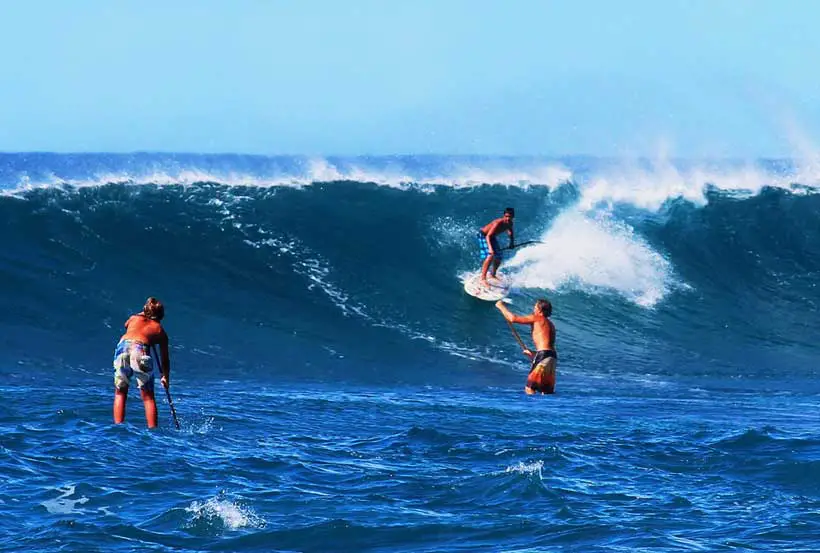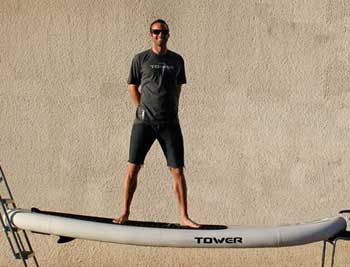I may get commissions for purchases made through links in this post.

I was strolling on the Ocean Beach Pier when, for the first time in my life, I saw SUP boarders catching waves.
A bit tired and not entirely satisfied from an afternoon of surfing I stood there, wide-eyed in astonishment of how easily these two guys were able to catch waves.
It particularly struck me how much more waves these stand up surfers were catching compared to the prone surfers sitting on their boards scanning the ocean.
These SUP boarders swiftly moved in and out the surf while making gestures informing each other of suitable waves to catch (they did respectfully let the prone surfers get their waves too).
It was at that amped moment when, all bright eyed and bushy tailed, I thought, that’s what I’m going to do!
It may have seemed easy back then, as turned out later, I did fool myself a little bit. The idyllic picture of those watermen reigning the periphery of the Ocean Beach surf didn’t convey the message that these dudes were pros.
After renting a SUP board and having my first experience I knew that, once again, looks can be deceiving. My first time on a stand up board on the waves was humbling. “Damn, this is harder than I thought it would be”.
I learned that, contrary to traditional wave surfing, you are using your whole body, from your feet and toes, your hips, to your upper body and arms. Everything is in constant strain to keep balance, to navigate, to gain enough speed to be able to catch an upcoming wave. Which is nice, I like a heavy workout. Not falling off and catching waves was kind of hard though. And then I’m not even mentioning the constantly climbing back on and standing up.
Despite this, I was hooked and after a short while I was in the market for my first SUP
There are a few personal reasons why I favor SUP’ing over surfing. I have a knee injury that flares up at certain activities. Stand up paddling is more forgiving for my knee. Not having to drag a massive board with me on sandy beaches and steep dunes ( I like to be out in the wild) but squeezing a lightweight inflatable package under my arm is a big advantage because of that knee.

So as a beginner I dig being able to catch more waves during a session. And then there’s another thing.
Look, I hate to break it to you but in some surf areas, as a SUP boarder or a beginning surfer there’s a chance you will be met with glowering looks and overall despise. If locals are looking daggers at you can paddle far away relatively easily to less crowded spots. Possibly even with little known breaks.
Yup, with a SUP you can increase you paddling area significantly. Allround use makes for a vast varied playground including sea coasts, breaking waves, lakes, rivers and canals. On top of that a wider range of conditions can be surfed as well.
Enough rambling, over to the nitty gritty.
Buying your first SUP. Which is better? An inflatable or solid board?
Once you know this activity is for you the question rises. Which board am I gonna purchase? Which type is the best SUP for beginners? An inflatable or a traditional fiberglass, carbon, or epoxy board?
To be honest, the first ads of inflatables I saw made me think of toys. Like these were inferior versions for kids or less serious practitioners. Doing my research and eventually paddling on one did prove me wrong.
It’s true that, initially, many of these boards were geared towards the very occasional paddler and punters who didn’t really care about performance. The last generation of inflatables have been pushing the limits. Enhanced construction methods leading to more rigid structures as well as removable fins have led to increased performance.
Comparison. Why I chose an inflatable SUP for my first board
We all know that each option has its own pros and cons. When it comes to stand up paddle boards, the benefits of an inflatable board as a first board for beginners weigh heavily against the downsides. At least, that’s my humble opinion. Let me explain.
It must be said, that determining what’s better for you, a solid sup board or an inflatable SUP board (iSUP) entirely depends on where you plan on using it and how you will store and transport it.
How will you use it?
This is the main question to ask yourself in order to find out which is better.
- If you do not plan on using it for serious wave surfing or for long distance and or optimal speed performance it’s pretty easy. Get an inflatable.
- If you do then there are still plenty reasons to get an inflatable. When being able to easily store and transport your board outweighs a little less performance, get an iSUP.
- Most of the time SUPs are used on flat water such as slow streams, canals, lakes or a flat ocean. If you will take your board on a hiking trip or another situation that requires flexibility in transport, in other words, if you want to be able to take it with you anywhere, go for a roll up (aka iSUP).
- Some will want to get into more specialist disciplines such as surfing, racing, or whitewater SUP boarding. For white water paddling getting an iSUP is a no-brainer. More in a bit.
- Some additional advice. When you will be surfing or be on white water look for a SUP with an upturned bow on the front end. Generally, pointed noses are best for touring and speed on calm, flat waters whereas round noses are better for maneouverability.
Transport
The advantages of an iSUP are that you can take it with you almost anywhere. You don’t need a large van or a pickup truck to haul your hard SUP board. Just roll it up into a convenient package that fits its carry bag and toss it in the trunk of your Ford Fiesta.
An inflatable is easily packed for a trip by airplane too. Hell, you can even pack it up and take the bus to Galveston Beach.
Especially if you have to bridge a longer distance from the vehicle to the waterfront an epoxy or fiberglass board can be a drag. Literally. These things can be collossal and heavy.
Recently I spotted this guy who had a relatively small model but the carrying hole wasn’t centered making lugging it from his van into the water a workout on its own. So if you do opt for a solid board, be sure to check this before buying.
Storage
If you own a spacious van or a car with a surfboard car rack and have large garage or shed at home storing a bulky SUP board isn’t likely to be much of a problem. If you don’t, picture yourself storing your big ass board every time you come home from paddling. An inflatable you simple store on a shelf.
Durability
Inflatables are more durable. You might not have thought so but these boards are very rugged and durable. Say you want to use it for white water river paddling. On an iSUP, hitting a rock in a fast flowing river has a much smaller chance on severely damaging your board.
Because the chance on having to visit a surf shop for repairs is way smaller with an iSUP you will feel less stressed out lending your board to friends or family for a first try. Let alone your own hesitance to defy spring rapids or rocky-shored beaches.
Price-wise
It is commonly expected that inflatables are considerably more affordable compared to hard boards but this is no set rule. In fact iSUPs may have the same retail price as rigid boards or can be more expensive even.
Commonly however, inflatables are less expensive which makes another argument for being the best board to start out with.
A common mistake many first time SUP board enthusiasts make is buying a first board that is too small for their size and weight. Especially when opting for a hard board going down a few sizes so it will fit in the car is tempting.
Cons
It wouldn’t be fair to omit mentioning the disadvantages of iSUPs. So here they are.
- Inflating does take some time. As does deflating.
- They are not as stable as hard boards. Especially with stronger wind or choppy water an inflatable will offer more of a challenge.
- If you are looking for optimal performance regarding speed and agility or for tricks while surfing a hard board is more appropriate.
- iSUPs can be very difficult to pump up with the included hand pump. Especially the getting the last psi’s in can be daunting. Since inflating it sufficiently is essential for performance you may have to look for a better pump. (i.e. electric or foot pump)
Performance
Especially for optimal performance when surfing or racing a hard board is better. The more tapered rails are better geared for waves and because of the material hard boards are more responsive. Those aspects do make these boards easier to use but on the other hand are more exploited by experienced users.
Rigidity of a solid board is a big advantage when surfing or paddling distances. You are better able to make subtle adjustments and glide through the water on a hard board. Some iSUPs are known to have flex which you don’t want.
Types of SUPs
Apart from inflatable or traditional there’s also the matter of types of boards. Depending on what you want to do with it you can choose from a surf, allround, cruiser and racer SUP. Each type has its own characteristics.
Other names are often given to basically the same type of SUPs. Names such as touring, fitness or yoga, or standard flat water board.
- Many people opt for an allround board. These have a good glide which makes them great for cruising while they are good for turning too which is necessary when surfing.
- When you primarily want to surf an inflatable surf SUP obviously will be your best fit. These smaller sized boards are less stable, paddle slower, but allow for the fastest turning. (Remember, for beginners who need the best surfing performance a solid board is recommended. Using the rail, making precise adjustments while turning to stay in the wave’s power pocket is asks for a solid board.)
- When spending your stand up paddling time on flat water covering large distances you will want a cruiser board. Cruiser SUPs are very stable and have better glide than the previously two types making them faster. Turning is more difficult than on an allround or surf SUP.
- Racer SUPs are the fastest because of their excellent glide. Just like surf boards these are less stable.
Note: all these different categories of boards come in inflatable versions.
Conclusion

SUP boards, both hard and blow up types, are making their way into surfs, lakes, canals and rivers. A swell of types and models has flooded the market and inflatables are starting to almost equal the performance characteristics of hard boards.
More and more inflatable SUP’s can be inflated to the extent that they are as rigid as a fiberglass board.
Here’s how to choose between rigid and roll-up.
- If you travel a lot and want to take your board with you.
- If you want to paddle in various locations that can not always be reached as easily by car.
- If you want to do white water paddling.
- Or if you want to buy your own high quality SUP for just a few hundred bucks.
- In any of these cases, the inflatable SUP is your golden ticket to stand up paddling walhalla .
While inflatables are known to improve on stiffness also make sure to get a relatively thick model since this will improve floatation as well. (for people weighing over 160lbs a 6 inch board is often recommended over a 4 inch model.)
Two recommended boards:
- The Tower Adventurer inflatable SUP for example, with it’s 6″ thickness providing extra support and amazing performance is a widely appreciated board.
- Another great board for if you want to try SUP boarding but don’t want to shell out the big bucks for a hard board is the, at less than $350 relatively affordable, 5″ thick Pathfinder Inflatable SUP (9-Feet 9-Inch).
One more thing to help ease your decision..
Most avid stand up paddlers have not one but several boards. Once the sport has gotten hold of you you are likely to buy more boards too.
Ultimately I’d like to get a hypoxy or fiberglass board, but thats probably a bit down the road. When deciding on my first board it didn’t take me long to pull the pin on an inflatable.
And a roll up SUP as an additional board is always great to have when you won’t be able transporting your rigid board. Or when you are taking a non-supping friend with you for a fun day on the beach.
In other words, if you ask me, and most experts agree, an inflatable SUP is an ideal beginners board which you won’t regret purchasing.
Click here to view Amazon’s most popular stand up paddle boards
What do you think? Will you be pumping up your first SUP?
Featured image by Flickr user Peggy2012CREATIVELENZ.























This article is awesome! Very helpful when you’re new to the world of SUPs thank you 🙂
That’s good to hear. Thanks for communicating Devyn
Thanks very much for the info. This was very helpful.
You say that iSUPs aren’t very well suited for “serious” wave surfing, so what about small waves (waist-high)? Are they suited for that??
Thanks!
You’re welcome Erc. They are suited for waves but rigid boards offer better performance. Inflatables can be (slightly) wobbly which is a disadvantage, especially when you want to take it to the next level. If your main goal is wave supping you’ll probably want the best experience you can get, so I’d go for a hard sup.
I agree Thijs, you’ll probably never see a pro surfer competing on an inflatable. But for waves up to head-high there are a couple of boards that can hold their own. The Red Paddle Co 8’10 Whip and the 9’8″ Ride are shaped to perform well in surf. The trick is to inflate them all the way up to 25 psi to get the rigidity they’re capable of. This allows them to break the surface tension between the water and the nose as you step back to catch the wave. (They also have ‘battens’ in the rails to increase rigidity) The Whip also has more nose rocker and a narrower pin-tail to help maneuverability in turns. As with any isup, rigidity is critical and these two boards come closest to the fiberglass feel while still packing up into a travel bag.
Nice read – I just got an inflatable with 3 fixed fins, am wondering if I should have paid more and got one with removable fins, won’t know the answer to that question till the water warms up and I can get in!
Thanks for the great insight! Do you have any thoughts on inflatable boards for yoga? I’d like a board I can use for both yoga and lake paddling. I’m wondering if calling a board a yoga board is more of a gimmick. Some seem wider but that’s about all I can find. Thanks!
‘Special’ yoga boards are, indeed, often extra wide and sometimes they feature flat front and backsides. The extra stability that is useful for yoga may inhibit its overall performance which I why I would opt for ‘just’ an inflatable board that is wide enough to do yoga poses on but is also made to cruise lakes etc.
Great article! I want to SUP with my German Shepherd and am wondering if an inflatable is suitable.
Thanks! I don’t see a reason why you couldn’t take your dog on an isup. In the worst case your GSD’s claws may scratch the board but other than some minor cosmetic damage to the board you’ll be fine.
Thank you for this really useful information. I like to paddle kayak but also think inflatable SUP really amazing. Inflatable always be my choice because of its “easy transportation”. Btw, where are you living now? Maybe in near time, I will meet you and surf with you 🙂
Great info thanks, but looking fory first sup,to be used in the ocean any suggestions on how long and width of my first sup should be?
Great article, Thanks Thijs!
I’ve seen pictures of people SUPing with their dogs and even read an article about using and iSUP with your pup. I have an ~80 lb black lab, do you think her nails would damage it? I’m not so concerned about balance.. I’m sure we’ll fall a ton, more so wondering if I should be concerned when it’s on the dock/shore or if she’s in the water swimming along side.
Thanks again!
Under cons you might add something about sharks. I was almost completely sold on the inflatable after reading your post, but am worried about a shark coming up for a little test bite. Then wouldn’t the whole thing deflate and I’d be toast?
Awesome article, thanks! That really helped!
Thanks man, appreciate the comment.
This was really helpful to me! Thank you for your insight.
I’ve been wanting to SUP but it seems so daunting. This article was very informative and reassuring. It’s probably the most informative article I’ve come across in doing SUP research (because I research hobbies before I start them, nerd, I know). Thanks so much!
Hi there fellow hobby researching nerd 😉 I’m currently researching electric unicycles, as a hobby and a means to get around my RV.
Waying up the pros and cons I think an inflatable SUP is more cost effective and don’t need a roof rack. Also great for traveling on holiday, just roll it up and take it with you. Tower boards are my favorite brand. I think they are good for doing yoga on them to, if you fall it takes the impact. Thanks for sharing!
This Article had my mind set on a ISUB board…..Until the last statement “When deciding on my first board it didn’t take me long to pull the plug on an inflatable”….Dangit…. I cannot make my mind up!
Great help though!!! Lots of awesome tips and points! Thank you!